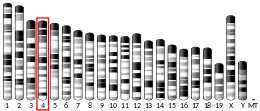NFIA
Nuclear factor 1 A-type is a protein that in humans is encoded by the NFIA gene.[5][6]
Function
Nuclear factor I (NFI) proteins constitute a family of dimeric DNA-binding proteins with similar, and possibly identical, DNA-binding specificity. They function as cellular transcription factors and as replication factors for adenovirus DNA replication. Diversity in this protein family is generated by multiple genes, differential splicing, and heterodimerization.[supplied by OMIM][6]
References
- GRCh38: Ensembl release 89: ENSG00000162599 - Ensembl, May 2017
- GRCm38: Ensembl release 89: ENSMUSG00000028565 - Ensembl, May 2017
- "Human PubMed Reference:". National Center for Biotechnology Information, U.S. National Library of Medicine.
- "Mouse PubMed Reference:". National Center for Biotechnology Information, U.S. National Library of Medicine.
- Qian F, Kruse U, Lichter P, Sippel AE (July 1995). "Chromosomal localization of the four genes (NFIA, B, C, and X) for the human transcription factor nuclear factor I by FISH". Genomics. 28 (1): 66–73. doi:10.1006/geno.1995.1107. PMID 7590749.
- "Entrez Gene: NFIA nuclear factor I/A".
Further reading
- Leahy P, Crawford DR, Grossman G, Gronostajski RM, Hanson RW (March 1999). "CREB binding protein coordinates the function of multiple transcription factors including nuclear factor I to regulate phosphoenolpyruvate carboxykinase (GTP) gene transcription". The Journal of Biological Chemistry. 274 (13): 8813–22. doi:10.1074/jbc.274.13.8813. PMID 10085123.
- das Neves L, Duchala CS, Tolentino-Silva F, Haxhiu MA, Colmenares C, Macklin WB, Campbell CE, Butz KG, Gronostajski RM, Godinho F (October 1999). "Disruption of the murine nuclear factor I-A gene (Nfia) results in perinatal lethality, hydrocephalus, and agenesis of the corpus callosum". Proceedings of the National Academy of Sciences of the United States of America. 96 (21): 11946–51. Bibcode:1999PNAS...9611946D. doi:10.1073/pnas.96.21.11946. PMC 18392. PMID 10518556.
- Nagase T, Kikuno R, Ishikawa KI, Hirosawa M, Ohara O (February 2000). "Prediction of the coding sequences of unidentified human genes. XVI. The complete sequences of 150 new cDNA clones from brain which code for large proteins in vitro". DNA Research. 7 (1): 65–73. doi:10.1093/dnares/7.1.65. PMID 10718198.
- Beausoleil SA, Jedrychowski M, Schwartz D, Elias JE, Villén J, Li J, Cohn MA, Cantley LC, Gygi SP (August 2004). "Large-scale characterization of HeLa cell nuclear phosphoproteins". Proceedings of the National Academy of Sciences of the United States of America. 101 (33): 12130–5. Bibcode:2004PNAS..10112130B. doi:10.1073/pnas.0404720101. PMC 514446. PMID 15302935.
- Xu H, Uno JK, Inouye M, Collins JF, Ghishan FK (February 2005). "NF1 transcriptional factor(s) is required for basal promoter activation of the human intestinal NaPi-IIb cotransporter gene". American Journal of Physiology. Gastrointestinal and Liver Physiology. 288 (2): G175-81. doi:10.1152/ajpgi.00396.2004. PMID 15458926. S2CID 14194207.
- Wang W, Stock RE, Gronostajski RM, Wong YW, Schachner M, Kilpatrick DL (December 2004). "A role for nuclear factor I in the intrinsic control of cerebellar granule neuron gene expression". The Journal of Biological Chemistry. 279 (51): 53491–7. doi:10.1074/jbc.M410370200. PMID 15466411.
- Champ PC, Maurice S, Vargason JM, Camp T, Ho PS (2005). "Distributions of Z-DNA and nuclear factor I in human chromosome 22: a model for coupled transcriptional regulation". Nucleic Acids Research. 32 (22): 6501–10. doi:10.1093/nar/gkh988. PMC 545456. PMID 15598822.
- Berry FB, O'Neill MA, Coca-Prados M, Walter MA (February 2005). "FOXC1 transcriptional regulatory activity is impaired by PBX1 in a filamin A-mediated manner". Molecular and Cellular Biology. 25 (4): 1415–24. doi:10.1128/MCB.25.4.1415-1424.2005. PMC 548007. PMID 15684392.
- Fazi F, Rosa A, Fatica A, Gelmetti V, De Marchis ML, Nervi C, Bozzoni I (December 2005). "A minicircuitry comprised of microRNA-223 and transcription factors NFI-A and C/EBPalpha regulates human granulopoiesis". Cell. 123 (5): 819–31. doi:10.1016/j.cell.2005.09.023. PMID 16325577. S2CID 6003724.
- Lin YL, Wang YH, Lee HJ (November 2006). "Transcriptional regulation of the human TR2 orphan receptor gene by nuclear factor 1-A". Biochemical and Biophysical Research Communications. 350 (2): 430–6. doi:10.1016/j.bbrc.2006.09.061. PMID 17010934.
- Olsen JV, Blagoev B, Gnad F, Macek B, Kumar C, Mortensen P, Mann M (November 2006). "Global, in vivo, and site-specific phosphorylation dynamics in signaling networks". Cell. 127 (3): 635–48. doi:10.1016/j.cell.2006.09.026. PMID 17081983. S2CID 7827573.
- Lu W, Quintero-Rivera F, Fan Y, Alkuraya FS, Donovan DJ, Xi Q, Turbe-Doan A, Li QG, Campbell CG, Shanske AL, Sherr EH, Ahmad A, Peters R, Rilliet B, Parvex P, Bassuk AG, Harris DJ, Ferguson H, Kelly C, Walsh CA, Gronostajski RM, Devriendt K, Higgins A, Ligon AH, Quade BJ, Morton CC, Gusella JF, Maas RL (May 2007). "NFIA haploinsufficiency is associated with a CNS malformation syndrome and urinary tract defects". PLOS Genetics. 3 (5): e80. doi:10.1371/journal.pgen.0030080. PMC 1877820. PMID 17530927.
External links
- NFIA+protein,+human at the U.S. National Library of Medicine Medical Subject Headings (MeSH)
This article incorporates text from the United States National Library of Medicine, which is in the public domain.
This article is issued from Wikipedia. The text is licensed under Creative Commons - Attribution - Sharealike. Additional terms may apply for the media files.



